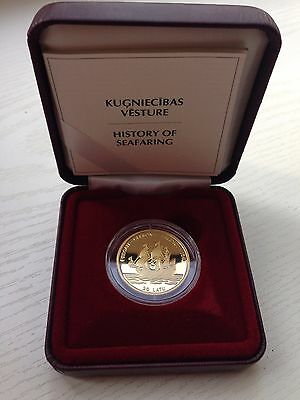-40%
History of Seafaring, Latvia gold coin Proof, Frigate "Gekrönte Ehlendt"
$ 580.79
- Description
- Size Guide
Description
Frigate "Gekrönte Ehlendt"Specifications
Face value: 20 LATS_MORE
Weight: 7.78 g, diameter: 25.00 mm
Metal: 583° gold
Quality:
proof
(with 24 kt gilding)
Maximum mintage: 5 000
Struck in 1997 by
Valcambi SA
(Switzerland)
Artists
Arvīds Priedīte
— graphic design
Jānis Strupulis
— plaster model
Obverse
The large coat of arms of the Republic of Latvia, with the year 1997 inscribed below, is placed in the centre. The inscriptions LATVIJAS and REPUBLIKA, each arranged in a semicircle, are above and beneath the central motif, respectively.
Reverse
The picture of a sailing-ship is depicted in the centre. The inscription FREGATE · GEKROENTE EHLENDT · 1642 (Frigate Gekroente Ehlendt 1642), arranged in a semicircle, is above the picture. The numeral 20 and inscription LATU (lats) are placed beneath the picture.
Edge
Reeded.
The 17th century was the time when shipbuilding developed in the Duchy of Courland and Semigallia, flourishing under the rule of Duke Jacob of the Kettlers (1642-1681). The largest of the Duchy's shipyards, where more than 120 frigates, galliots, corvettes and other sailing ships were built, was established near Ventspils (Windau) in 1638. Most of these ships carried cargoes to various countries, among them to the two colonies belonging to Duke Jacob: St. Andrew's Island in the Gambia estuary, Africa, and Tobago Island in the South of the Small Antilles, Central America.
The colours of the Duchy's merchant ships were rectangular and bicoloured. The area of the rectangle was divided diagonally; one part was crimson with a white rectangle in the centre, while the other had a crimson rectangle against a white background.
The sailing ships were given Latin, French, Dutch and German names, carrying either abstract or concrete meaning, for example,
Fidelitas
,
Fortuna
,
Innocentia
,
Justitia
,
Der Baer
,
Der Walfisch
and
Die Butte
.
The building of the
Gekroente Ehlendt
(The Crowned Elk), the frigate depicted on the reverse of the coin, was started in Ventspils on March 9, 1642. The length of this three-masted sailing-ship was 28.3 metres, and her carrying capacity was 320 tons. The
Gekroente Ehlendt
set on her maiden voyage on May 18, 1643. The ship was in the Duke's fleet until 1645, when she was seized by Spanish pirates.









